The Morgan Library and Museum Presents: It’s Alive! Frankenstein at 200
By Nava Atlas | On October 22, 2018 | Updated October 25, 2020 | Comments (0)
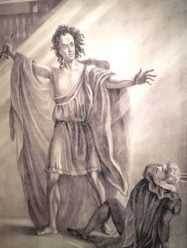
For fans of the hugely influential 1818 novel Frankenstein and admirers of its author, Mary Wollstonecraft Shelley, late fall 2018 – early winter 2019 was an exciting time at The Morgan Library and Museum. This lovely museum celebrated the 200th anniversary of the publication of this classic with a fascinating exhibit.
For more on the curation and development of this exhibit, see our related post, It’s Alive! Frankenstein at 200. Learn more about the exhibit here. The show was introduced as follows:
“Mary Shelley’s Frankenstein; or, The Modern Prometheus — in which a chemistry student makes a living being out of corpses — has compelled our attention since it was first published in 1818. This exhibit explores its adaptability to stage and screen, its sources in Gothic art and Enlightenment Science, and the haunted life of its creator.”
How Frankenstein came to be
Frankenstein has long been acknowledged as one of the most important forerunners of modern science fiction. The genesis of the novel is well known to Mary Shelley nerds: In 1814, the teenaged Mary Wollstonecraft Godwin and the poet Percy Bysshe Shelley (a disciple of her father’s) fell in love.
Later that year, the pair eloped to Europe, starting a chain of events that would alter both of their lives. Mary became part of Shelley’s literary circle. In 1816, during a visit to Lord Byron in Switzerland, the group of writers challenged themselves to a task of writing a “ghost story,” as this genre of the supernatural seemed to be in vogue.
An idea didn’t come easily to Mary, but when it did, it wholly possessed her: “I saw the hideous phantasm of a man stretched out, and then, on the working of some powerful engine, show signs of life, and stir with an uneasy, half vital motion.”
Mary was just eighteen at the time, and when it was published, she was barely twenty-one. It bears noting that in the story, Victor Frankenstein is the creator of the monster, who is referred to primarily as “the creature.”
On view is the 1831 edition of Frankenstein, in which Mary Shelley finally came out of anonymity. It’s in this edition that she related the entire story of how she came to write Frankenstein.
The exhibit: It’s Alive! Frankenstein at 200
The exhibit is thoughtfully arranged in two spaces: One explores the influences that may have impacted and made it possible for Mary, a relatively sheltered young woman from England, to have given birth to such a tale.
The path to its publication and immediate aftermath are also traced. The second space takes a look at how the novel took root in the public imagination with staged plays and operas in the 19th century and film in the twentieth.
Some non-flash photography of some portions of the exhibit is allowed, and I’ve shared a few selected images following. But there is so much more to see!
For anyone who has never visited The Morgan, you’re in for a treat. Though it’s a well-visited place, it’s also an oasis of calm in near midtown Manhattan, and a respite from the crowdedness of other museums. Make sure to allow for extra time to enjoy the other exhibits that are running concurrently to It’s Alive! Frankenstein at 200.
. . . . . . . . . .
The iconic painting of Mary Shelley was on display
It was a thrill to come upon the well-known portrait of Mary Shelley from 1831. She was at the height of her fame, and already a widow — Shelley had drowned in 1822. And of the several children she had borne, only one son survived.
Mary grew up in an era of scientific and technological discovery. Despite the fact that her early life is described as sheltered, she was part of an enlightened and educated family. It’s quite possible that she learned of some of the experiments and breakthroughs of her time.
Most of Mary Shelley’s original manuscript from 1816 – 1817 has survived. A few sample pages to view as part of the exhibit; it’s incredibly intimate to see the author’s own hand, and even more fascinating with the addition of Percy Shelley’s editorial suggestions.
Frankenstein was published in three volumes, as was the style in that era. Something I learned, according to The Morgan: “Sir Timothy [Percy Shelley’s father] loathed his son and daughter-in-law and forbade her to publish under the Shelley name.
Nonetheless. she wrote productively for some years after as “the author of Frankenstein.” The initial print run was 500 copies; probably quite respectable at the time, but a fraction of what the book would eventually sell.
Frankenstein was first staged in London in 1823 and made its author famous. According to The Morgan: “The monster was portrayed by an expressive pantomime actor. Audiences loved it. More than a dozen other theatrical productions appeared, followed by the film version, less than a century after the novel.”
. . . . . . . . . .
Frankenstein, or, the Modern Prometheus, New York: Grosset and Dunlap, [1931].
Courtesy of The Morgan Library & Museum and Universal Studios Licensing LLC, © 1931
Universal Pictures Company, Inc. Photograph by Janny Chiu
. . . . . . . . . .
Because the 1931 film starring Boris Karloff became so iconic, it’s less known that the Edison Studios produced the first movie version of Frankenstein in 1910. None of the films have truly captured the simple story and emotional depth at the heart of Mary’s book, though. And so the monster, a Halloween cliché, has taken on a life of its own apart from the original book.
Quoting The Morgan: “James Whale’s 1931 film made Boris Karloff the face of Frankenstein for generations of viewers, and versions in other media — comic books, illustrations, prints, and posters — testify that Mary Shelley’s ‘hideous progeny’ is very much alive.”
There’s an abundance of film clips, posters, and other memorabilia to see in this section of the exhibit, in which photography wasn’t allowed. You can even see the fright wig worn by Elsa Lancaster in Bride of Frankenstein, the highly successful sequel to the original film.
The Morgan’s gift shop had plenty of Mary Shelley and Frankenstein-related literature to browse through!
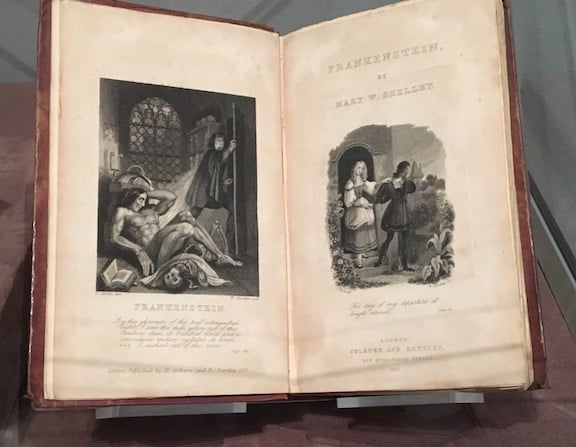
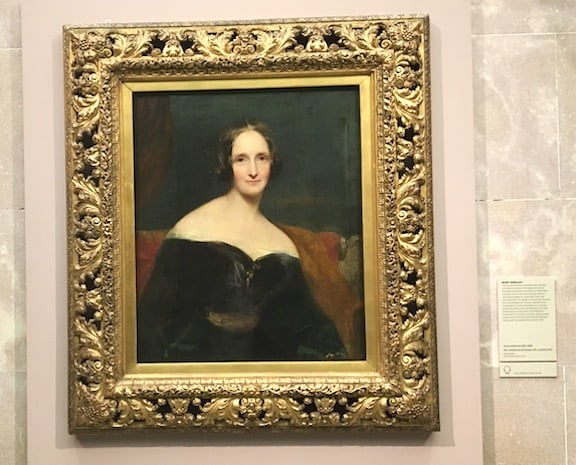
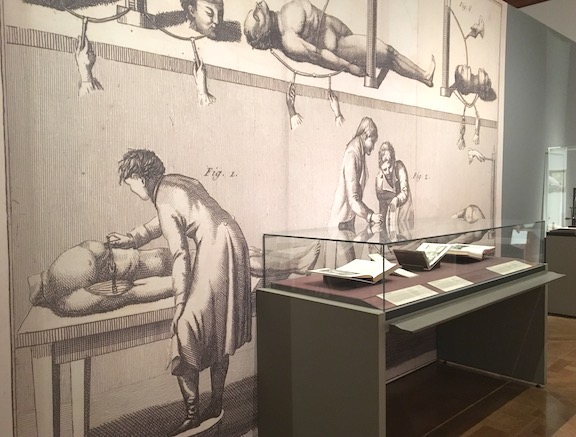
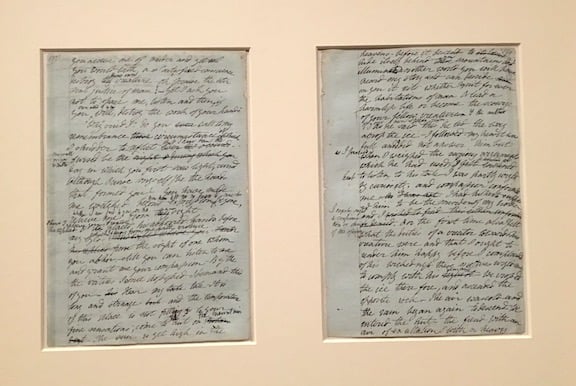
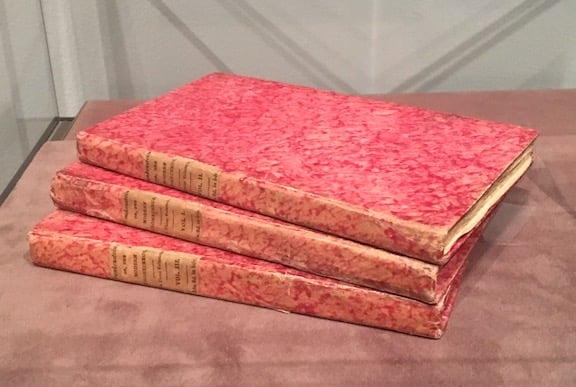
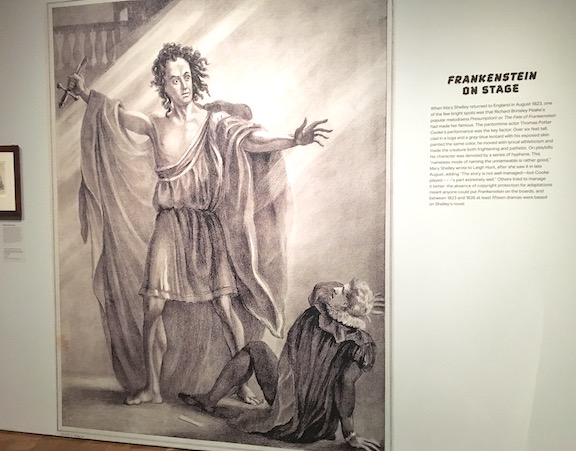
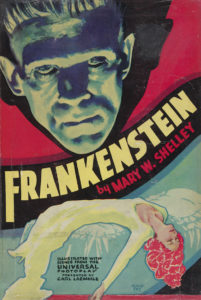
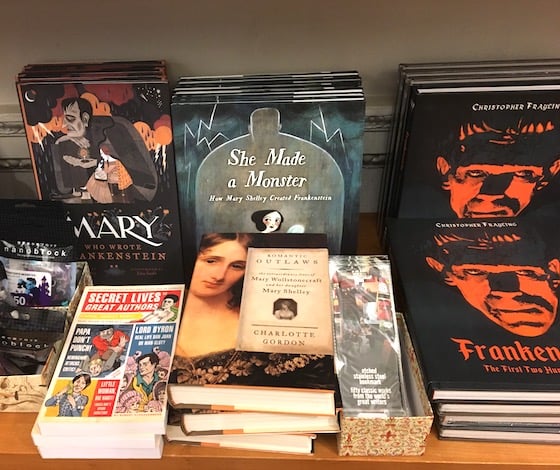
Leave a Reply